Marching bands are an integral part of many school events, parades, and halftime shows. These ensembles are not only visually impressive but also produce powerful and captivating music.
If you’re interested in joining a marching band but are unsure where to start, I will introduce you to the five easiest marching band instruments to learn. Whether you’re a beginner or have some musical background, these instruments offer a great entry point into the exciting world of marching band music.

Benefits of Learning Marching Band Instruments
Before we jump into the specific instruments, let’s explore the benefits of learning a marching band instrument. Participating in a marching band can be a rewarding experience that goes beyond the joy of playing music.
It offers an opportunity to develop discipline, teamwork, and leadership skills. Additionally, marching band members often form lasting friendships and create unforgettable memories through their shared musical journey.
Criteria for Ease of Learning
When determining the ease of learning a particular instrument, several factors come into play. These include the instrument’s
- Size
- Weight
- Complexity
- Availability of learning resources
- Instrument’s role within the marching band
Instruments that have a simpler playing technique and a more prominent role in the band tend to be more beginner-friendly.
Easiest Marching Band Instruments to Learn
Now, let’s explore the five easiest marching band instruments to learn. These instruments offer a relatively gentle learning curve, making them suitable for beginners and those with limited musical experience.
Snare Drum
The snare drum is a staple of marching bands, providing a strong rhythmic foundation. Its compact size and lightweight design make it an excellent choice for beginners.
Basic techniques involve rudiments, such as paradiddles and flams, which are relatively easy to learn. Popular marching band music often features snare drum cadences and exciting rhythmic patterns.
Size
The snare drum is compact and manageable in size, making it easier to handle, especially for beginners.
Its smaller dimensions allow for better control and comfort while playing, as well as convenient transportation during marching band performances.
Weight
Compared to other marching band instruments, the snare drum is relatively lightweight. This factor contributes to its ease of learning, as players can focus more on developing technique and coordination without being burdened by excessive weight. The lighter weight also reduces physical strain during long rehearsals or performances.
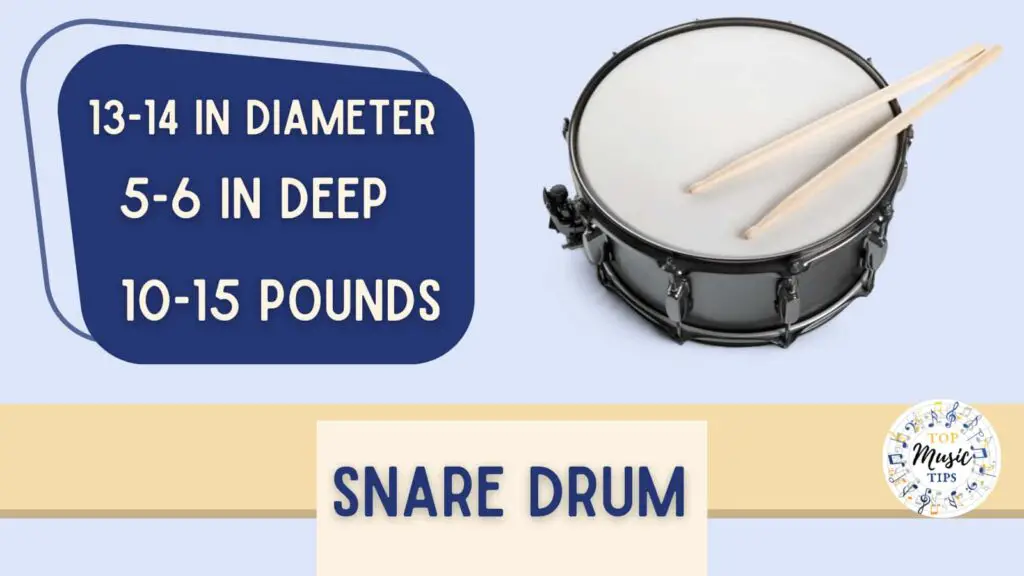
Complexity
The snare drum has a simpler construction and playing technique compared to other percussion instruments. The basic techniques involve using sticks or mallets to strike the drumhead, producing a variety of sounds and rhythms.
Beginners can quickly grasp fundamental rudiments, such as single strokes, double strokes, and paradiddles. With practice and guidance, students can progress to more intricate patterns and techniques.
Availability of Learning Resources:
Learning resources for the snare drum are widely accessible. There are numerous instructional books, online tutorials, video lessons, and educational materials dedicated to teaching snare drum techniques and exercises.
These resources provide step-by-step guidance, notation, and audiovisual demonstrations, making it easier for aspiring drummers to learn and improve their skills.
Snare Drum’s Role within the Marching Band
The snare drum plays a crucial role in the marching band’s rhythmic foundation. It often carries the primary snare drum cadences, providing the backbone of the ensemble’s sound.
Note: The prominence and repetitive nature of the snare drum’s parts make it an ideal instrument for beginners to develop timing, coordination, and a strong sense of pulse within the band’s performance.
Considering these factors, it becomes evident why the marching snare drum is considered one of the easiest instruments to learn in the marching band setting.
Its size, weight, simplicity, availability of learning resources, and important role within the ensemble all contribute to a smooth and accessible learning experience for aspiring drummers.
Cymbals
Cymbals add a brilliant and dynamic element to the marching band’s sound. They are among the easiest instruments to learn, as they primarily require the player to clash the cymbals together in various ways. Learning the different playing techniques, such as crashes, rolls, and chokes, allows for
Size
Cymbals are typically available in a variety of sizes, ranging from 14 inches to 20 inches or more in diameter.
Despite their larger size compared to other handheld instruments, cymbals are still manageable for beginners. The size allows for easy gripping and control, facilitating the learning process.
Weight
Similar to the snare drum, cymbals are relatively lightweight, especially when compared to other percussion instruments like the bass drum or multi-tenors.
This lightweight nature enables players to focus on mastering the proper technique without being encumbered by excessive weight. It also reduces physical strain during extended rehearsals and performances.
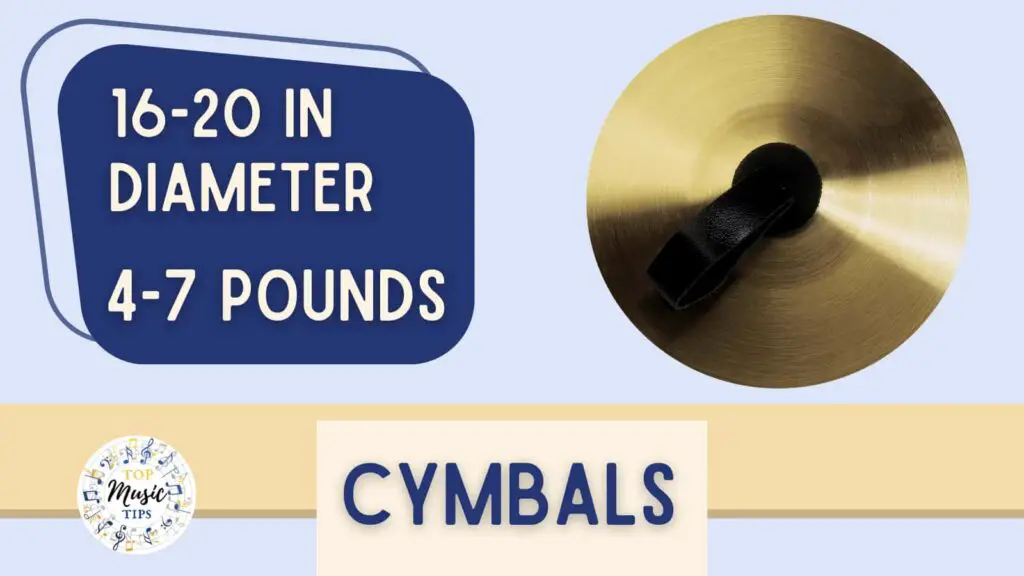
Complexity
The playing technique for cymbals is relatively straightforward, making it easier for beginners to learn. The primary action involves clashing the cymbals together, producing a range of expressive and dynamic sounds.
Techniques such as crashes, rolls, and chokes can be quickly understood and practiced. As beginners gain confidence and proficiency, they can incorporate more intricate cymbal patterns into their playing.
Availability of Learning Resources
Learning resources for cymbals are widely accessible, allowing beginners to find valuable educational materials. Online tutorials, video demonstrations, and instructional books provide step-by-step guidance on cymbal techniques, hand positions, and musical applications.
These resources help beginners understand the basic techniques and provide exercises to enhance their skills.
Cymbal’s Role within the Marching Band
Cymbals play a significant role in the marching band’s overall sound and visual performance. They add a brilliant and dynamic element to the music, enhancing its impact. The simplicity of cymbal playing makes it easier for beginners to integrate into the ensemble’s performance, contributing to the band’s overall rhythmic drive and intensity.
Flute/Piccolo
For those inclined towards woodwind instruments, the flute or piccolo is an excellent choice for marching band. These instruments are lightweight, portable, and relatively easy to learn.

With a focus on melody and harmony, flute and piccolo players often play important parts in the band’s overall musical arrangement. Basic techniques include proper finger placement, breath control, and producing a clear tone.
Size
The flute and piccolo are both compact and lightweight instruments, making them easy to handle and carry during marching band performances.
Their smaller size allows for better control and maneuverability while playing, especially when on the move. Beginners find it comfortable to hold and play these instruments, which contributes to a smoother learning experience.
Weight
Flutes and piccolos are among the lightest instruments in the marching band. They are made of materials such as silver, or nickel, which keeps their weight minimal.
The lightness of these instruments allows beginners to focus on technique and playing expression without being burdened by excessive weight during rehearsals or performances.
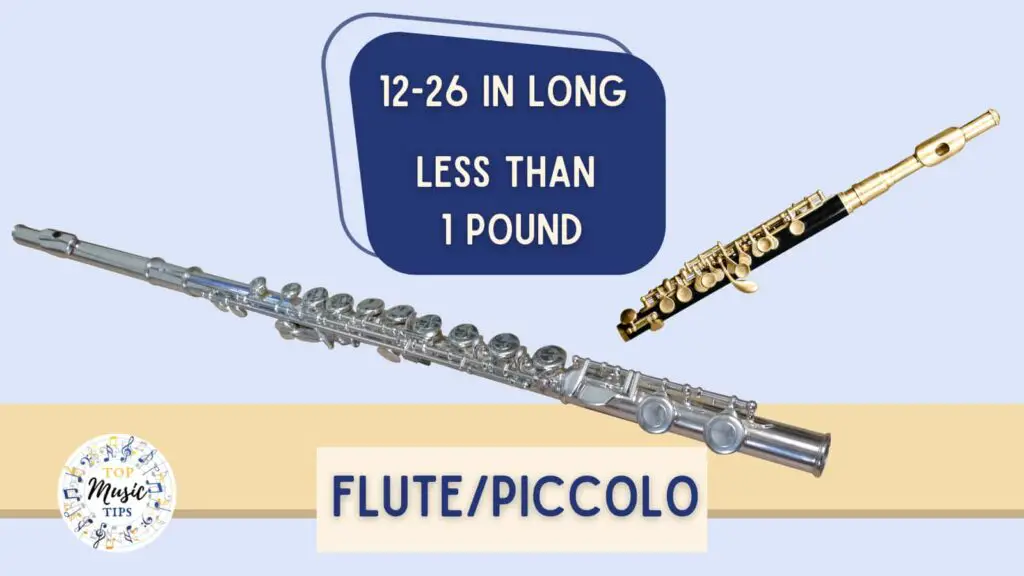
Complexity
The flute and piccolo have a straightforward fingering system and a relatively simple playing technique compared to many other instruments.
Beginners can quickly learn the basic fingerings and produce clear tones. As they progress, they can explore more advanced techniques such as articulation, vibrato, and extended techniques. The simplicity of the flute and piccolo contributes to an easier learning curve for beginners.
Availability of Learning Resources
I can attest that Learning resources for the flute and piccolo are widely available, making it easier for beginners to access educational materials.
There are a ton of online videos, and tutorials on YouTube as well as method books specifically tailored for flute and piccolo players that offer step-by-step guidance, exercises, and repertoire selections. These resources assist beginners in understanding proper embouchure, fingerings, breath control, and musical expression.
Flute & Piccolo’s Role within the Marching Band
The flute and piccolo contribute to the overall sound and musical color of the marching band. Their piercing and melodic tones cut through the ensemble, adding a distinct and vibrant character to the music. Beginners playing the flute or piccolo have the opportunity to showcase their musicality and contribute to the band’s overall sonic impact.
Trumpet
As a brass instrument, the trumpet offers a vibrant and distinctive sound in marching bands. While it may require a bit more effort to produce a good tone, the trumpet is still considered one of the easier brass instruments to learn. Basic techniques involve mastering the embouchure, fingerings, and breath control. Trumpet players often play melodic lines, harmonies, and occasional fanfares, contributing to the overall brass section’s brilliance.
Size
The trumpet is a compact and portable instrument, making it easy to handle and carry during marching band performances.
Its smaller size allows for better control and maneuverability while playing, whether standing or on the move. Beginners find it comfortable to hold and play the trumpet, which contributes to a smoother learning experience.
Weight
Trumpets are relatively lightweight instruments, allowing players to focus on technique and musical expression without being burdened by excessive weight.
The materials used in trumpet construction, such as brass or silver, contribute to their manageable weight. This lightness also reduces physical strain during long rehearsals and performances.
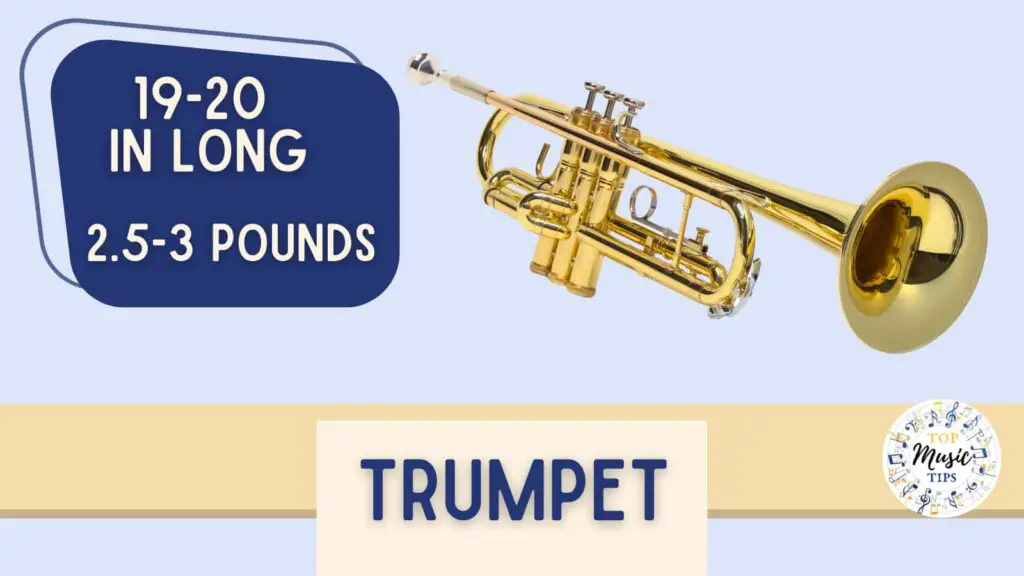
Complexity
While the trumpet requires learning specific fingerings and embouchure techniques, it is considered one of the more accessible brass instruments for beginners. The trumpet’s valves provide a straightforward system for playing different pitches, and the embouchure (lip position and airflow) can be quickly grasped with proper guidance. Beginners can start with simple melodies and scales, gradually progressing to more complex music.
Availability of Learning Resources
Learning resources for the trumpet are widely accessible, making it easier for beginners to find educational materials.
Online tutorials, instructional videos, and method books dedicated to trumpet playing offer valuable guidance, exercises, and repertoire selections. These resources help beginners understand proper technique, breathing exercises, and musical interpretation.
Trumpets Role within the Marching Band
The trumpet is a prominent instrument in the marching band, often carrying melodic lines and playing fanfares. Its bright and powerful sound adds a distinctive flair to the ensemble’s performance.
Beginners playing the trumpet have the opportunity to develop their musicality, blend with other brass instruments, and contribute to the band’s overall sound and energy.
Considering these factors, it is evident why learning to play the trumpet in a marching band can be considered relatively easy. The trumpet’s compact size, manageable weight, straightforward playing technique, availability of learning resources, and significant role within the ensemble all contribute to a smooth and accessible learning experience for aspiring trumpet players.
Bass Drum
You might be surprised to see the Bass drum on this list. If the only factor we were taking into account where the size then there is no way the Bass drum would deserve a place here, but that’s only part of the full picture!
Because the bass drum is another instrument that offers a relatively straightforward learning experience we felt it should be included.
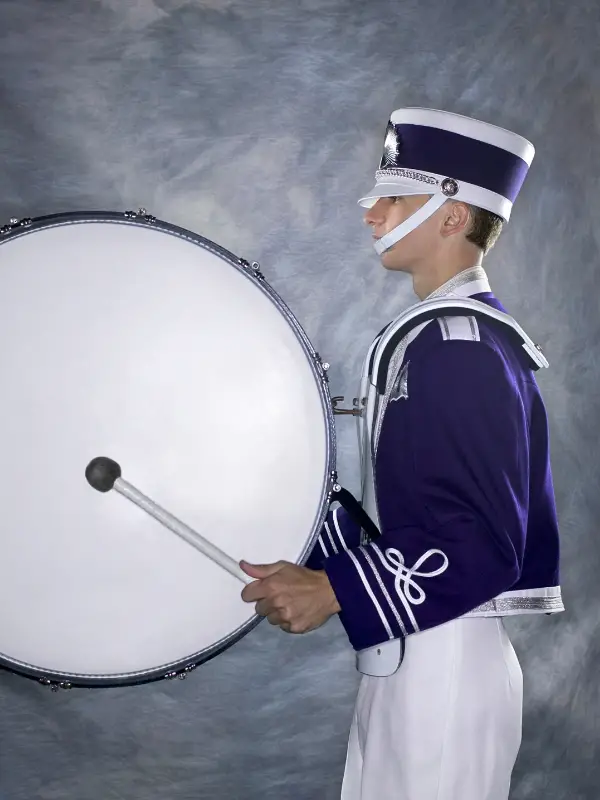
As the largest instrument in the marching band, it produces a deep and powerful sound that drives the ensemble’s rhythm.
Basic techniques involve striking the drumhead with mallets or using a foot pedal. Learning various rhythms and patterns enables bass drum players to contribute to the band’s overall groove.
Size
The bass drum is the largest instrument in the marching band’s percussion section.
Its size provides a substantial striking surface, making it easier for beginners to produce a deep and powerful sound. Despite its larger dimensions, the bass drum is designed to be comfortably played while marching, allowing for convenient mobility during performances.
Weight
While the bass drum is larger in size, it is still manageable in terms of weight.
Manufacturers often use lightweight materials to construct marching bass drums, ensuring that players can handle and carry them comfortably.
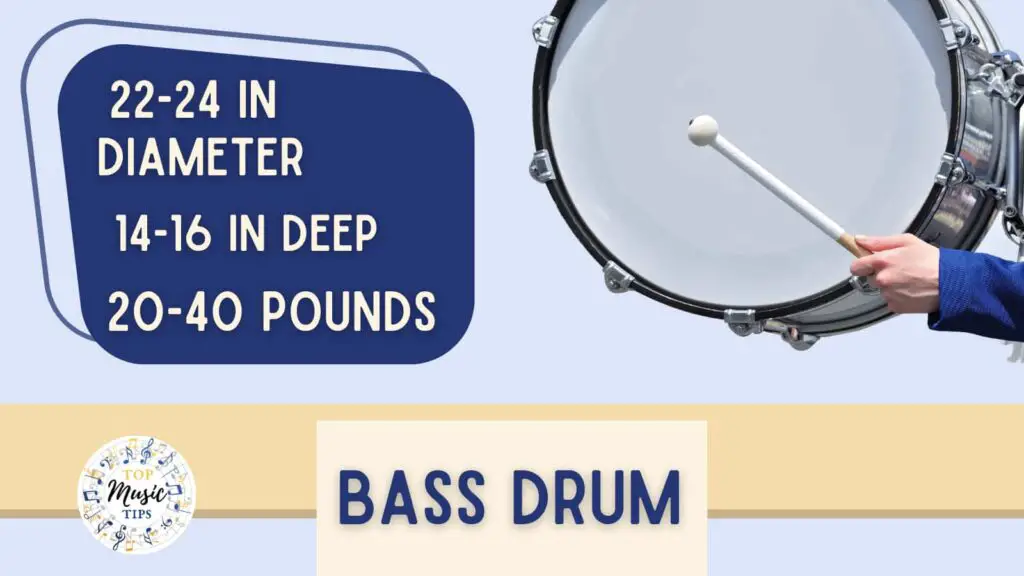
Complexity
The bass drum offers a relatively straightforward learning experience. The basic technique involves striking the drumhead with mallets or using a foot pedal. Beginners can quickly grasp the concept of maintaining a steady rhythm and playing basic patterns. As they progress, they can explore more intricate techniques and learn to incorporate different accents and dynamics into their playing.
Availability of Learning Resources
Learning resources for the bass drum are readily available, making it easier for beginners to learn and improve their skills.
Instructional books, online tutorials, and video lessons provide valuable guidance on proper technique, rudiments, and musical applications specific to the bass drum. These resources offer a wealth of exercises and examples to support learners in their journey.
Bass Drums Role within the Marching Band
The bass drum plays a vital role in establishing the rhythmic foundation and providing a driving force within the marching band. Its deep and resonant sound adds a sense of power and impact to the ensemble’s performance. Beginners can quickly find their place in the band’s overall sound by focusing on maintaining a solid beat and following the conductor’s cues.
Tips for Learning a Marching Band Instrument
Regardless of the instrument you choose, here are some tips to enhance your learning experience:
- Find a qualified instructor or join a local marching band program.
- Practice regularly and establish a consistent practice routine.
- Break down challenging passages into smaller, manageable sections.
- Utilize online resources, tutorial videos, and sheet music to support your learning.
- Seek opportunities to perform and gain experience in a group setting.
- Remember, learning a musical instrument requires dedication, patience, and perseverance. Embrace the learning process, and you’ll soon reap the rewards of your efforts.

Conclusion
Learning a marching band instrument opens up a world of musical possibilities and personal growth. Among the easiest instruments to start with are the snare drum, cymbals, bass drum, flute/piccolo, and trumpet. These instruments offer accessible techniques and significant roles within the marching band. By following the tips provided and investing time and effort into your practice, you’ll develop the skills necessary to contribute to the mesmerizing performances of a marching band.
FAQs
Can I learn a marching band instrument without prior musical experience?
Absolutely! Many marching band programs welcome beginners with no prior musical experience. With dedication and proper guidance, you can learn and excel in playing a marching band instrument.
How long does it take to become proficient in playing a marching band instrument?
The time it takes to become proficient varies from person to person. It depends on factors such as your commitment, practice routine, and the complexity of the instrument. With regular practice and guidance, progress can be made within a few months to a couple of years.
Are these instruments suitable for all age groups?
Yes, marching band instruments are suitable for all age groups. Whether you’re a student in school or an adult looking to pursue a new hobby, there are opportunities available for individuals of all ages to learn and play these instruments.
What other benefits can I gain from learning a marching band instrument?
In addition to musical skills, learning a marching band instrument promotes discipline, teamwork, leadership, and time management skills. It also offers opportunities for personal expression, boosts self-confidence, and provides a sense of belonging within a community of musicians.
How can I find a marching band to join in my area?
To find a marching band in your area, you can start by reaching out to local schools, community centers, or music organizations. They often have information about marching band programs or can direct you to groups in your community. You can also search online for marching bands or musical ensembles in your city or town. Social media platforms and online classifieds may have listings for marching band auditions or open positions. Attending local parades or events where marching bands perform can also provide opportunities to connect with band members or directors.
Once you find a marching band to join, reach out to them and inquire about auditions or beginner-friendly programs. They may have specific requirements or training sessions for new members. Be prepared to demonstrate your interest, enthusiasm, and willingness to learn. Remember, joining a marching band is not only about playing an instrument but also about being part of a tight-knit musical community.
In conclusion, learning a marching band instrument is an exciting and fulfilling journey. The five easiest marching band instruments to learn, including the snare drum, cymbals, bass drum, flute/piccolo, and trumpet, offer excellent entry points for beginners. By embracing the learning process, seeking guidance, and practicing regularly, you can develop the skills needed to contribute to the mesmerizing performances of a marching band. So go ahead, choose an instrument that resonates with you, and embark on this musical adventure. The joy of marching band music awaits you!
We hope this article has been helpful and informative for you in your musical journey. Please let us know if there is anything that we could add or change to make this article a better resource for our readers.
Please e-mail us at: [email protected] to let us know how we are doing!
Disclaimer: This post may contain affiliate links. We only recommend high-quality products that are used and recommended by real musicians. If you use these links to buy something we earn a small commission.
